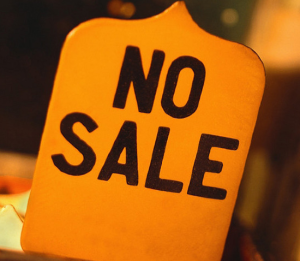By Carolyn Edlund
Frustrated by all those potential art sales you didn’t make? Here’s why they slipped through your fingers.

The average art sale isn’t made on the spur of the moment, on impulse or by one visit to an art website. Making a sale is quite frequently a matter of building trust. And that means staying in touch. It takes multiple contacts to even be remembered by potential collectors. And it takes more than that to close the sale.
“I guess I’m not really all that good at follow up,” an artist confessed recently. He explained why he hadn’t sold all the work he wanted to sell. He was most likely right in his assumption, but he’s not alone.
A common problem
Most professional salespeople aren’t that good at follow up either, and they are selling for a living! A revealing sales survey asked salespeople why they didn’t follow up with leads. The biggest reason? Fear of rejection.
And another study found that 44% of salespeople give up after hearing “no” only once, even though it takes approximately five contacts to land a sale. In fact, only 2% of sales are made on the first meeting.
So if you are feeling badly about not getting back in touch with people who have an interest in your work, you have lot of company. But that doesn’t change the fact that you are leaving a lot of sales on the table if you don’t make a point to contact people who should be collectors of your art.
You might be thinking “Am I bothering them?” But in fact, staying in touch with people who have expressed interest in your work (and especially when they have given permission by signing up for your blog or email list) is actually sharing a positive message which they have agreed to receive!
Getting results
A regular connection means that when the time comes for your prospective customer to move forward with a purchase, they will think of you. They like your work, they know you from your communications, and your professional message. And the basics of marketing are being developed. Getting people to know, like and trust you is a cornerstone of your small business.
Part of your follow up may be connecting to your prospects on social media, where they see your posts and images of your artwork in their Facebook or Twitter stream. This is a passive way to keep your work in front of them.
A more active way to stay in touch is the use of email marketing, which is the most effective tool in follow up. And the great news is that unsubscribe rates are very low for the artist community. People love artwork and they find you fascinating! Use that fact to your benefit and make a point to create clear, interesting and appealing emails on a regular basis to your prospective customers.
Ultimately, sales is a numbers game, since only a percentage of interested people will buy your work. When you regularly follow up, you increase those odds because you haven’t lost touch with your potential collectors – and you haven’t lost the sale.


I look forward to checking out the course. Many of us cannot attend the workshops and the online course would be a great solution.
Sure hope to see the “how to build an email list” section. How to get those precious emails besides doing the art festivals and having the “sign up for my newsletter” on the website and social media.
Thanks for all the great articles – they have been super helpful and if I had known about the strategy on the business cards I could have gotten a few emails. Now I know and will use it on an upcoming event 🙂
Sue, I hope you had a chance to take the survey. Many artists are concerned about building that list, and that is a whole section of our upcoming course!
Yay! I’ll go now and take the survey.
I”m excited just to use the business card info for this fall’s events.
Look forward to the info.
wow…5 times!!! Okay…now that I know I will do better!! Thanks you’ve inspired me!!
And, it takes 7-10 contacts to even be remembered by people you are marketing to. So if that sounds even more daunting, be assured that it isn’t that hard. You can keep people in the loop by using a marketing calendar to reach out to them in so many ways – invitations, emails, direct mail, social media, in-person events.
Just take a look at the amount of contacts you receive when you make a purchase from a retailer or manufacturer. You hear a lot from them, don’t you? They know that to stay “top of mind” you must be in contact. It works!